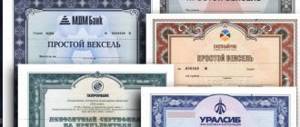Types of debt securities in the modern economic environment are represented quite widely: promissory notes, credit agreements, loan agreements, etc. At the same time, there is a security that is given a special place in Russian legislation and business practice - a bill. The legal features of the use of promissory notes and bills of exchange are reflected in the text of Federal Law No. 48 dated 11/03/97 “On bills of exchange and promissory notes”. It is based on the norms of international bill of exchange law, in particular the Geneva Convention of 1930. The subject of this article is a bill of exchange - the most complex form, in contrast to the traditional simple one.
What are the differences between a promissory note and a bill of exchange ?
What is a bill of exchange?
Before studying what a promissory note is, as well as what its other varieties are, let’s study the essence of the corresponding document. The term “bill” is usually understood as a security that is issued to certify the debt of one business entity in relation to another, but the rights to collect the debt can be transferred by the second party to the transaction to third parties. It is not necessary to obtain the debtor's consent.
According to some researchers, bills of exchange are among the historically earliest types of securities. Their appearance was preceded by ordinary promissory notes. That is, their possession guarantees that the creditor will receive funds; no other legal confirmation of the corresponding preference is required. It may be noted that bills of exchange can be issued by both individuals and organizations. Technically, the corresponding payment instrument can be issued in any paper format - on letterhead or on a regular blank sheet.
Difference between bills of exchange and other securities
It is useful to consider how a bill of exchange differs from a bond of a similar legal nature, which is also generally considered to be an unpersonalized debt obligation.
The key criterion for distinguishing between the two financial instruments noted is the subject of the debt. In the case of a bill of exchange, this is cash, less often - a certain product. The subject of the debt on the bond is the share of participation in the share capital of the company. But there are other differences between the mentioned financial instruments:
- bonds are usually subject to registration by the state, bills of exchange are a financial instrument freer from formalities, although, of course, it can be regulated by various legal acts, such as the law on a promissory note or a bill of exchange;
- In some cases, bills can be used to make payments instead of those made in cash; bonds are not intended for these purposes;
- The main legal mechanism for the formation of bonds is the conclusion of a purchase and sale agreement; bills of exchange are transferred by order of the current owner.
The payment instrument in question may be part of the company's documentation. So, if a company has received a promissory note, accounting for the corresponding source must be carried out in accordance with the requirements of accounting legislation. Actually, it will be useful to consider the key legal provisions that regulate the circulation of the financial instruments in question.
Areas of application
Why do you need a bill:
- when lending to individuals and legal entities, it is considered reliable collateral for the loan, the borrower issues it to his lender;
- to attract capital, for example, banks and enterprises do not need to go through a complex procedure for issuing shares or bonds if funds are needed for development;
- for mutual settlements between enterprises with the possibility of offsetting mutual claims;
- to pay for transactions by non-cash means;
- acts as an independent object of purchase and sale;
- To defer payment, the buyer issues a document to the seller of goods and services.
Governing legislation
The main source of law establishing the legal circulation of bills of exchange in Russia is Federal Law No. 48, adopted on February 21, 1997. This law states, in particular, that the circulation of the payment instruments in question in the Russian Federation correlates with the provisions of the Convention of 06/07/1930, which establishes a uniform law on bills of exchange. Also in Federal Law No. 48 there is a clause according to which the Resolution of the Council of People's Commissars of the USSR should be applied on the territory of the Russian Federation, which introduced the Regulations regulating the circulation of promissory notes and bills of exchange and adopted on 08/07/1937. Thus, it can be noted that a bill of exchange is an instrument , is absolutely not new for the Russian economy. It was also used in the USSR.
Article 2 of Federal Law No. 48 states that the execution and payment of a promissory note or a transfer bill can only be carried out with the participation of citizens and legal entities registered in the Russian Federation. Relevant activities with the participation of authorities at the federal, regional or municipal level can be carried out only in those cases provided for by federal legislation. An exception is legal relations in which bills of exchange were issued before the entry into force of Federal Law No. 48.
Article 3 of Federal Law No. 48 states that interest on a bill of exchange should be calculated based on the discount rate of the Central Bank of the Russian Federation. Another noteworthy nuance regarding the turnover of the payment instruments in question, which is contained in Federal Law No. 48, is that filling out a bill of exchange (promissory note or transfer) must be carried out only on paper. This is another difference between bills of exchange and bonds, which can also be electronic.
Let us now study in more detail the varieties in which the financial instrument in question can be presented.
Classification of bills
There are 2 main types of bills, as we noted above, considering the legislative basis for regulating the circulation of these securities - simple and transferable. Let's study their specifics.
A promissory note requires that the debtor, or maker of the note, fulfills his payment obligation to the creditor upon the due date. A bill of exchange includes an option whereby settlements with the eligible owner of the underlying security can be made upon the due date for partial repayment by the drawer. The obligation to transfer the remaining amount of the debt may be assigned to the drawer's counterparties who have receivables to him. But the second scheme is not very popular, since the holder of the bill of exchange must agree that there will, in fact, be two obligated persons, and perhaps more. Many companies consider this payment mechanism unreliable. Therefore, a promissory note is generally considered a more preferable financial instrument. In Russia it is considered significantly more widespread than the translated one. Let's study its specifics in more detail.
Features of a bill of exchange of an individual
The bill, as a state-issued security, is delivered to commercial banks through the central bank of the state. And already in commercial banks, bills of exchange can be purchased by legal entities and individuals. Only persons who have special certificates for carrying out such operations can sell blank bills.
Note 1
In accordance with current legislation, only banks can issue bills of exchange in Russia. But individuals can purchase them at banking institutions. To fill out the bill, you need the help of a specialist. Otherwise, the bill may be invalidated. That is why individuals fill out a bill of exchange in banks, observing all the necessary details.
In many cases, the use of bills of exchange by individuals allows them to reduce the tax burden, arrange payment of income taxes in installments, or defer their payment. Individuals can use bills of exchange for donation, sale, or exchange. The use of a bill of exchange is facilitated by the fact that the holder of the bill is not required to prove the origin of the bill in court. Therefore, a bill of exchange can also be used in settlements between individuals - to convey the right to receive debts or to pay for the receipt of goods without attracting fixed capital.
Such a wide range of applications for bills of exchange is very beneficial for private entrepreneurs, as it allows them to quickly resolve many credit and financial issues promptly, without unnecessary bureaucracy.
Specifics of a promissory note
Promissory notes imply an unconditional obligation of the drawer towards the creditor, correlating with the terms contained in the document. The corresponding payment instrument usually accompanies commodity transactions. Its registration may be due to the buyer’s lack of funds in the required amount at the time of receipt of the relevant products. In this case, the subject of legal relations issues a bill of exchange, under which he undertakes to pay the supplier in the future. As soon as the calculations are made, the corresponding document is returned by the creditor to the drawer.
Requirements for drawing up a promissory note
It will be useful to consider how a promissory note should be correctly drawn up. The key criterion here is the indication of the necessary details on the document form. A promissory note is a form that has very few elements. Thus, it is necessary, first of all, to indicate that the source securing debt obligations is precisely the bill of exchange. This term must be included in the text of the document. Also, the structure of the source must contain language guaranteeing payment by the drawer of a specific amount. The document must indicate the dates and place of its preparation, the coordinates of the settlement object, and the deadlines for fulfilling payment obligations. The bill must contain the details of the payee, as well as the signature of the drawer. It is highly undesirable to use a facsimile instead. In this case, the debtor may formally refuse to repay the promissory note, citing the fact that he did not issue it. But other elements of the document are also important. If they are not included in the structure of the payment instrument in question, then it may also be declared invalid. What might a promissory note look like? A sample structure of the corresponding document is shown in the photo below.
Please note that the legislation does not require filling out the bill manually or on a computer. The main thing for the creditor and debtor is to agree on the terms of settlement and correctly record them in the document. A promissory note, a sample structure of which is presented above, is adapted for use in commercial legal relations. As for bank settlements or debt relationships involving individuals, the structure of the relevant document may be slightly different. But the main thing is to include in it the points that we mentioned above.
Bill and endorsement
The payment instrument in question is often used in payments between commercial enterprises. Thus, a bill of exchange received by a company from a partner can be presented for redemption or used as an instrument for payment for the supply of goods, services or work performed. The second procedure involves the use of endorsement - an order to transfer the right to a debt claim. The original holder of the bill - the endorser - can indicate on the bill the name of the new holder of the security, certify it with a signature, after which the partner will be able to use the financial instrument in question for his own purposes.
It is important that the endorser, who has a promissory note or a transferable note in his hands, writes on the back of the document “Pay in favor of so and so” so that the drawer is aware of who becomes the new holder of the debt. Endorsements, however, come in several varieties. There is a nominal one, which assumes that the structure of the payment document in question will contain: the name of the endorser, his signature and seal.
There is a blank endorsement in which the name of the endorser is not intended to be indicated. Such a simple interest-bearing bill (or a bill of exchange) is considered to be issued to the bearer. In this case, the endorser has the right to enter into the document the name of the new holder of the corresponding payment instrument, and in this case the endorsement becomes personal. The procedure under consideration may fall into the collection category, when the endorser gives the bank the right to present the bill for payment. There is a collateral endorsement, when the corresponding payment instrument can be a means of securing a loan.
Transfer of rights
For the mobility of a security, the possibility of its presentation by another person is used. When merchants receive them from counterparties, they can either present obligations for payment or use them to pay for goods and services. This can be done using an endorsement - an endorsement. On the reverse side, the holder of the bill (endorser) indicates to whom he is transferring the form, puts a date and signature.
What are the endorsement options?
The transfer of rights can be complete or partial; the bill of exchange is transferred with or without the details of the beneficiary (personal endorsement). Businessmen insure themselves against joint liability when transferring rights by drawing up non-negotiable bills of exchange, indicating in the note “without negotiability on me.”
Interest on bills
The provision adopted back in the USSR - on a promissory note, on a transferable bill - allows the subjects of legal relations to agree on the return of funds, taking into account interest accrued on the principal amount of the debt. All you need to do is indicate the appropriate conditions in the text of the bill of exchange form. In general, interest is accrued from the date of drawing up the payment document in question. But it may also contain other dates.
The specifics of calculating interest on bills may vary depending on the specifics of the activities of the subjects of legal relations. For example, banks usually fix a simple discount rate for a bill of exchange, calculated on the same principle as any other credit rate.
Collection of bill debt
One of the advantages of a bill is the ease of assignment of the right to claim the debt under it. But its main attraction is that collection of a bill of exchange debt is possible in a simplified manner: not through a lawsuit, but through writ proceedings. Cases regarding the issuance of a court order are considered by a magistrate (subclause 1, clause 1, article 23 of the Code of Civil Procedure of the Russian Federation).
In case of evasion of payment on a bill of exchange, its holder must contact a notary office. The notary will present the unpaid bill to the debtor. And if this demand for payment is refused, then the notary draws up a deed in a special form called a “protest of non-payment.” Based on a notarial protest, the judge alone issues a court order, which has the force of an executive document (Article 121, Article 122 of the Code of Civil Procedure of the Russian Federation).
note
The drawer of the bill is not the owner of his bill. This document certifies his commitment. Therefore, the issuance of a bill of exchange is not considered a sale of a security (letter of the Main Directorate of the Bank of Russia for Moscow dated September 18, 1997 No. 05-1-20/1728, resolution of the Presidium of the Supreme Arbitration Court of the Russian Federation dated November 24, 2009 No. 9995/09).
Writ proceedings are conducted without trial and without summoning the parties to hear their explanations. A court order is issued within five days from the date of receipt of the application from the claimant (Article 126 of the Code of Civil Procedure of the Russian Federation). An application for a court order is paid with a state fee in the amount of 50 percent of the rate established for statements of claim (clause 2 of Article 123 of the Code of Civil Procedure of the Russian Federation). But this procedure has a vulnerable side. The judge sends a copy of the court order to the debtor, who, within ten days from the date of receipt of the order, has the right to submit objections regarding its execution. If objections are received from the debtor, the judge cancels the court order (Articles 128, 129 of the Code of Civil Procedure of the Russian Federation).
In this regard, you need to remember: with a simple bill, the drawer has the right to raise objections arising from the civil contract between them against the first bill holder’s demand for payment of the bill. For example, if a bill of exchange was issued instead of an advance under a supply agreement, but the delivery did not take place (clause 9 of the information letter of the Presidium of the Supreme Arbitration Court of the Russian Federation dated July 25, 1997 No. 18). There are also no grounds for collecting funds on a bill of exchange if the holder of the bill, when purchasing the bill of exchange, acted deliberately to the detriment of the debtor (clauses 17, 77 of Resolution No. 104/1341).
Settlements on bills
Let us now consider how settlements for the payment instruments under consideration can be carried out in practice. The most important condition characterizing a promissory note is the maturity date. In accordance with the provisions of the Resolution of the USSR Council of Ministers, the corresponding payment document can be issued for the following period:
- scheduled for a specific date;
- correlating with the moment of presentation of the bill;
- correlated with the moment of drawing up the payment document;
- involving payment of a debt upon presentation of a bill of exchange.
Documents in which the terms are indicated differently than in the specified paragraphs or require sequential calculation are considered invalid.
In accordance with the provisions of the Resolution of the USSR Council of Ministers, bills that are payable at sight must be transferred to the drawer for redemption within 1 year from the date of drawing up the document. At the same time, the debtor has the right to pay the creditor earlier or stipulate a longer period. Also, the settlement period for bills of exchange can be adjusted taking into account the position of the endorser.
The debtor may establish that a payment obligation payable upon sight cannot be transferred by the creditor for repayment earlier than a specific date. If, for example, a bill of exchange is issued for one or several months, then settlements on it must be made on the corresponding day of the month in which the debt is repaid. If there is no 31st day in a particular month, which corresponds to the day the bill was drawn up, then settlements are made on the 30th.
It may well be that the corresponding payment document will be issued for a month and a half. In this case, you first need to count, as follows from the provisions of the Resolution of the USSR Council of Ministers, whole months. It is possible that the bill will be assigned at the beginning, middle or end of the month. In this case, the settlement dates will fall on the 1st, 15th or last day of the month, respectively. In the text of the bill, you can specify a specific number of days after which the debt will have to be repaid - for example, “eight days” or “twenty days”. At the same time, it is permissible to write “half a month” - in this case the bill is considered issued for 15 days.
If a promissory note (or bill of exchange) must be paid on a specific day and place that uses different dating principles, then the due date must be used based on the appropriate criteria - based on the calendar of the place where the payment is made. The text of the bill may specify other conditions for determining dates in the event of a discrepancy between calendar standards.
Making payments on a bill of exchange
The next most important aspect that is useful to consider is the bill settlement procedure. In accordance with the provisions of the Resolution of the USSR Council of Ministers, the holder of the corresponding payment document due for repayment on a specific day must present it to the drawer on the established date or 2 days later if they are working days. The payer has the right to demand from the creditor a receipt indicating that payment has been received. It is not permissible to force the bill holder to receive funds before the established settlement date. In the process of repaying obligations under a bill of exchange, the parties must check the correctness of the data on the endorsement, if it was applied.
If the holder of the bill does not present the relevant payment document for repayment on time, then his debtors will have the right to deposit the amount of the debt in favor of the competent authority.
Promissory note loan
The issue and placement of promissory notes is used to attract borrowed funds. In such cases, the bill replaces the loan agreement. The accrual of interest must be provided for in the bill itself. The debt is repaid by the borrower by paying the bill presented to him for repayment.
Example 5
Let’s use the conditions of example 1. I received 100,000 rubles from my current account. and issued a bill of exchange with a maturity date of “at sight” and an interest rate of 25 percent per annum. The bill is repaid within a calendar month in 20 days. The accountant will make notes:
DEBIT 51 CREDIT 76
– 100,000 rub.
– funds have been received; DEBIT 76 CREDIT 66 subaccount “Bill loan” – 100,000 rubles. – own bill of exchange was issued in connection with the loan relationship; DEBIT 91 CREDIT 66 subaccount “Interest on a bill” – 1370 rubles. (RUB 100,000 x 25% x 20 days: 365 days) – interest accrued on the bill; DEBIT 66 CREDIT 51 – 101,370 rub. (100,000 + 1370) – the presented bill is repaid.
Bills of exchange in foreign currency
A promissory note, as well as a bill of exchange, can be issued in a currency that is not used at the place of payment. In this case, the amount of the debt must be paid by the drawer at the exchange rate on the day of repayment of the debt. If the debtor is in arrears, the holder of the bill has the right to demand from him that the corresponding amount be paid at the most convenient rate - calculated on the established payment date or on the date of actual settlement. The corresponding indicator is established in accordance with the rules that apply at the place of payment.
At the same time, the drawer has the right to invite the creditor to indicate the exchange rate in the text of the bill. It is allowed to issue appropriate payment obligations, subject to settlements in a specific currency. The drawer's expenses in this case will depend on how profitably he will buy foreign currency.
Features of investing in bill drawer companies
As with deposits, the return on investment in bills of exchange depends on the period and size of the investment. The yield on securities of banks with a high reliability rating is lower than deposits by an average of 2-5%. Less stable banking companies offer favorable rates on investments in bills.
Reasons for the profitability of a bill of exchange for investments:
- liquidity;
- projected profitability;
- mobility of a financial instrument;
- ease of use.
It is important to remember the disadvantages of investing in debt securities
- high price of bills;
- possibility of early repayment with loss of potential profit;
- lack of insurance;
- payment of income tax 13%.
Verification of bills of exchange
We noted above that the form used as a medium on which a promissory note is drawn up can have the most elementary structure. It does not have to be branded or have any degree of protection. How is the authenticity of a bill of exchange verified, given its very simple structure and limited security against possible counterfeits?
Thus, a common method is by which the authenticity of the financial instruments in question is verified by telephone. If this is, for example, a simple bank bill, then the recipient of this security can call the financial institution and find out whether it was actually issued by the institution. Many enterprises practice a similar scheme. In some cases, organizations can issue upon request official certificates that confirm the fact of issuing a particular bill.










